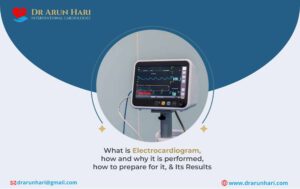What is Atrial Flutter?
Atrial flutter is a type of supraventricular tachycardia that originates in the atria of the heart. It results in rapid, regular atrial contractions, typically around 250–350 beats per minute, leading to ineffective atrial contractions and poor ventricular filling.Step-by-Step Guide to Identifying ECG of Atrial Flutter
Step 1: Look for the Classic Sawtooth ECG Pattern
The hallmark of an ECG of atrial flutter is the presence of a distinctive sawtooth wave pattern in the inferior leads (II, III, aVF). These repetitive flutter waves occur due to rapid atrial depolarization.Step 2: Assess the Ventricular Rate
While the atria contract at a rapid rate, the AV node may block some impulses, leading to a ventricular rate of 75–150 beats per minute. This helps differentiate a flutter ECG from other tachyarrhythmias.Step 3: Compare with Normal ECG vs Atrial Fibrillation
Unlike atrial fibrillation, where P waves are absent and the rhythm is irregular, a flutter ECG shows a regular pattern. When comparing a normal ECG vs atrial fibrillation, flutter waves are a distinguishing feature.Step 4: Rule Out Other Arrhythmias
Some conditions can mimic atrial flutter. For example, in a ventricular flutter ECG, QRS complexes are wide and bizarre, indicating a different origin of arrhythmia. In contrast, atrial flutter typically presents with a narrow QRS complex.Why Early Diagnosis is Critical
When left untreated, atrial flutter can increase the risk of stroke by five times. Additionally, untreated atrial flutter can progress into atrial fibrillation, making management more complex. Recognizing ECG findings of atrial fibrillation early is essential for optimal treatment.Expert Diagnosis with Dr Arun Hari
Dr Arun Hari, with extensive expertise in interventional cardiology, offers state-of-the-art diagnostic services. His in-depth knowledge of atrial fibrillation flutter ECG patterns ensures that patients receive the most accurate diagnosis and effective treatment plans.Treatment Options for Atrial Flutter
- Medications: Rate-control and rhythm-control medications are prescribed to manage atrial flutter.
- Electrical Cardioversion: A controlled electric shock restores normal rhythm.
- Catheter Ablation: This procedure, performed by Dr Arun Hari, is the most effective long-term solution, eliminating the abnormal electrical circuit causing the flutter.
Don’t Ignore the Signs – Take Action Today
If you or a loved one experience palpitations, dizziness, or shortness of breath, seek medical attention immediately. Early detection of atrial flutter ECG abnormalities can prevent life-threatening complications. Book a Consultation with Dr Arun Hari NowFAQ: How to Identify atrial flutter ECG & Solutions by Dr. Arun Hari
If you suspect an irregular heart rhythm or have been diagnosed with atrial flutter, you might have several questions regarding how it appears on an ECG and what can be done about it. Below are some frequently asked questions answered by Dr. Arun Hari, an experienced interventional cardiologist.
An atrial flutter ECG is an electrocardiogram recording that shows the presence of atrial flutter, a type of abnormal heart rhythm characterized by rapid and regular atrial contractions. The atria beat too fast, leading to inefficient blood pumping and an increased risk of complications like stroke.
The ECG of atrial flutter typically shows regular, rapid flutter waves instead of normal P waves. These flutter waves are best seen in leads II, III, and aVF. The atrial rate usually ranges between 250-350 beats per minute, but the ventricular response may vary depending on conduction through the AV node.
A a flutter ECG presents with distinct and evenly spaced flutter waves. Unlike atrial fibrillation, which causes an irregularly irregular rhythm, atrial flutter typically maintains a regular rhythm unless there is variable AV conduction.
The sawtooth ECG pattern refers to the characteristic flutter waves seen in atrial flutter. These waves resemble a “sawtooth” shape and occur at a rapid rate without a clear isoelectric baseline. This is one of the most distinctive features of an atrial flutter ECG.
When comparing a normal ECG vs atrial fibrillation, the key difference is rhythm regularity. A normal ECG shows clear P waves with a steady rhythm, whereas atrial fibrillation causes an irregularly irregular rhythm with fibrillatory waves instead of P waves.
The ECG findings of atrial fibrillation include:
- Absence of distinct P waves
- Irregularly irregular RR intervals
- Fibrillatory waves in baseline
These findings help differentiate atrial fibrillation from atrial flutter, which has a regular rhythm with flutter waves.
A ventricular flutter ECG is a severe arrhythmia where the ventricles contract at extremely high rates (150-300 bpm), often leading to hemodynamic collapse. Unlike atrial flutter, this condition originates in the ventricles and presents with wide, monomorphic QRS complexes without a clear P-wave.
Dr. Arun Hari offers a range of treatment options, including:
- Medications: To control heart rate and prevent clot formation.
- Electrical Cardioversion: A procedure to reset the heart rhythm using electrical shock.
- Catheter Ablation: The most effective long-term solution, which destroys the abnormal electrical pathways causing atrial flutter.
Dr. Arun Hari is a leading interventional cardiologist with expertise in diagnosing and treating atrial flutter and other arrhythmias. His precision in interpreting ECG findings of atrial fibrillation and performing advanced procedures like catheter ablation ensures the best outcomes for patients.
Get Expert Care for Atrial Flutter Today
If you suspect atrial flutter or have been diagnosed with an irregular heartbeat, early intervention can prevent severe complications like heart failure and stroke. Don’t wait—consult with Dr. Arun Hari for the best cardiac care available.
Book a Consultation with Dr. Arun Hari Now




